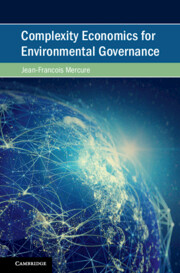Book contents
- Frontmatter
- Contents
- Figures
- Tables
- Preface
- Acknowledgements
- Part I The State of Knowledge and its use in Environmental Economics
- Part II A Positive Theory for Complexity Economics
- Part III Applied Complexity Economics for Environmental Governance
- 12 Risk-Opportunity Analysis for Transformative Policy Design and Appraisal
- 13 A Science–Policy Interface for the Energy–Water–Food Nexus
- 14 Technology Dynamics in a Rapid Low-Carbon Transition
- 15 Macroeconomics and Structural Change in a Rapid Low-Carbon Transition
- 16 Conclusions and Outlook
- References
- Index
14 - Technology Dynamics in a Rapid Low-Carbon Transition
from Part III - Applied Complexity Economics for Environmental Governance
Published online by Cambridge University Press: 03 November 2022
- Frontmatter
- Contents
- Figures
- Tables
- Preface
- Acknowledgements
- Part I The State of Knowledge and its use in Environmental Economics
- Part II A Positive Theory for Complexity Economics
- Part III Applied Complexity Economics for Environmental Governance
- 12 Risk-Opportunity Analysis for Transformative Policy Design and Appraisal
- 13 A Science–Policy Interface for the Energy–Water–Food Nexus
- 14 Technology Dynamics in a Rapid Low-Carbon Transition
- 15 Macroeconomics and Structural Change in a Rapid Low-Carbon Transition
- 16 Conclusions and Outlook
- References
- Index
Summary
This chapter explores technology dynamics, and policies to influence the direction of technological change, for addressing climate change. `Optimal’ policy to address climate change has been the topic of substantial debate. In the standard environmental economics framework, one pricing policy should be used per market failure, and that policy is expected to exactly fix the externality and solve the problem. For climate change, this is a carbon price. Socio-technical systems are, however never in equilibrium, but rather are in constant change. Here, insights from Chapters 7 to 8 are brought together to formulate a dynamic model of co-evolutionary technology diffusion and learning. The model is used to analyse policy design in key sectors that matter for climate change. Synergies and interference effects exist between different types of policy approaches, and this indicates that for technological change policy, welfare economics is a poor framework to design technology policy, as optimality is ambiguous. Instead, simulations can help identify smart and effective policy strategies that accelerate technological change in desired directions.
- Type
- Chapter
- Information
- Complexity Economics for Environmental Governance , pp. 350 - 372Publisher: Cambridge University PressPrint publication year: 2022



